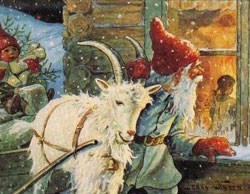
 Illustration by T. Rasmussen/ Provided by Sue Weaver |
Nowadays, reindeer are the Christmas critters du jour, but we goats used to bring on Christmas cheer! Mom wrote an article about the Yule goat, which you can read, if you want to.
Long ago, in Scandinavia, country folk believed in wee fairies. Swedish fairy spirits were called tomte; Norwegians and people in Denmark called them nisse. They believed the wee folk took care of their homes and children and protected them from misfortune, especially at night, when they were asleep. Tomte especially loved horses and sometimes braided knots in their manes and tails. If you picked and brushed the snarls out, that made the tomte mad. Then they played terrible tricks on the farm folk. Tomte could be dangerously scary!
 Illustration by Jenny Nyström/ Provided by Sue Weaver |
After the Christianization of Scandinavia, variants of the tomte and nisse—called the jultomte in Sweden, julenisse in Norway and tontuu in Finland—started bringing the Christmas presents in Sweden and Norway, instead of the traditional julbock (the Yule goat). They wear red, but they’re still small—not big and jolly like Santa Claus—and they deliver gifts in sleighs drawn by goats or carry the presents pack-style on a goat’s back.
A lady named Jenny Nyström began painting Christmas cards starring jultomte and goats in the late 1800s. Her son, Curt Nyström Stoopendahl, followed in her footsteps, as did many Scandinavian artists. You can buy vintage originals and modern reproductions of these cards at eBay. Mom collects old ones (some of them are pictured above). You could too!




